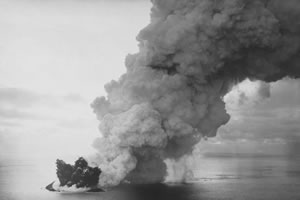Surtsey is a volcanic island that broke through the surface of the sea on November 14, 1963.
On that date, journalists and scientists traveled from all over the world to witness the birth of this island of the coast of Iceland.
The eruption column, which occasionally rose as much as 15,240m (50,000ft), could be seen from Reykjavik, Iceland's capital, around 120km (75mi) to the northwest.
 After two days of observation, scientists were able to discern an object in the heart of the dense, billowing cloud.
After two days of observation, scientists were able to discern an object in the heart of the dense, billowing cloud.
A huge ridge of rock began to take shape. Before long an island, about 40m (130ft) in height and 550m (1,800ft) in length, was clearly visible.
The Place Name Committee of the government of Iceland named the volcano Surtur, after a Scandinavian fire god.
By the end of January 1964, the growing island, now named Surtsey, rose about 150m (500ft) above the sea and covered about 2.6sq.km (1sq.mi), an area roughly half the size of New York City's Central Park.
Scientists suspected that it would exist only for a short period, since the pumice and ash of the tephra, the island's chief constituent, would be unable to resist the battering of the waves and wind.
 However, in February 1964, the northwest face of Surtsey erupted, and a second volcano poured out large streams of lava. As the lava spread outward from the cone of this volcano, named Surtur Junior by watching scientists, it flowed over the tephra and solidified into a tough shield at the island's northern edge.
However, in February 1964, the northwest face of Surtsey erupted, and a second volcano poured out large streams of lava. As the lava spread outward from the cone of this volcano, named Surtur Junior by watching scientists, it flowed over the tephra and solidified into a tough shield at the island's northern edge.
Eventually lava flowed out of Surtur itself and mingled with the tephra to form a substance that could withstand the fiercest storms.
The eruptions on Surtsey ceased altogether in 1967.
Mid-Atlantic Ridge
Surtur is one of many volcanoes to have erupted from the Mid-Atlantic Ridge. This mountain chain, most of it below sea level, runs for more than 16,000km (10,000mi) down the centre of the Atlantic Ocean from Jan Mayen Island in the north to the Bouvet Island in the south.
Iceland is the largest above-sea island of the ridge. All of its satellite islands have, like Surtsey, appeared from beneath the ocean
Life on Surtsey
The creation of a brand new island gave scientists an opportunity to study how plants and animals colonize sterile territory.
From the moment of its creation, Surtsey became a laboratory.
Visitors were forbidden lest they inadvertently brought seeds or spores with them in their clothes or on their footwear. Only teams of scientists wearing sterile clothing were permitted to land on the island to investigate the volcano and any signs of life.
The island's shore was first colonized by bacteria, molds, seaweeds and green algae.
After three years, mosses took hold on the lava. They were followed by lichens five years later.
Enough seeds arrived, either borne on the wind or else airlifted by seabirds, to produce a scattering of grasses and sedges.
In 1970, fulmars and black guillemots started nesting in cliffs on the western side of the island.
Surtsey has since become a stopping point for migratory birds, such as geese and swans.
Seals, which live in the surrounding waters, have also been seen basking on the island.